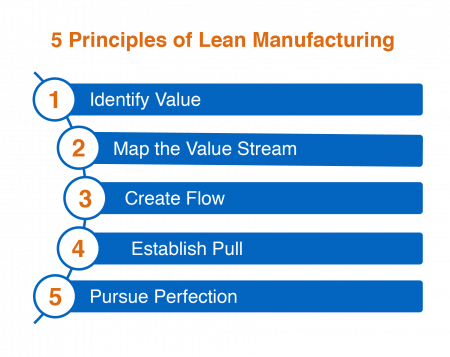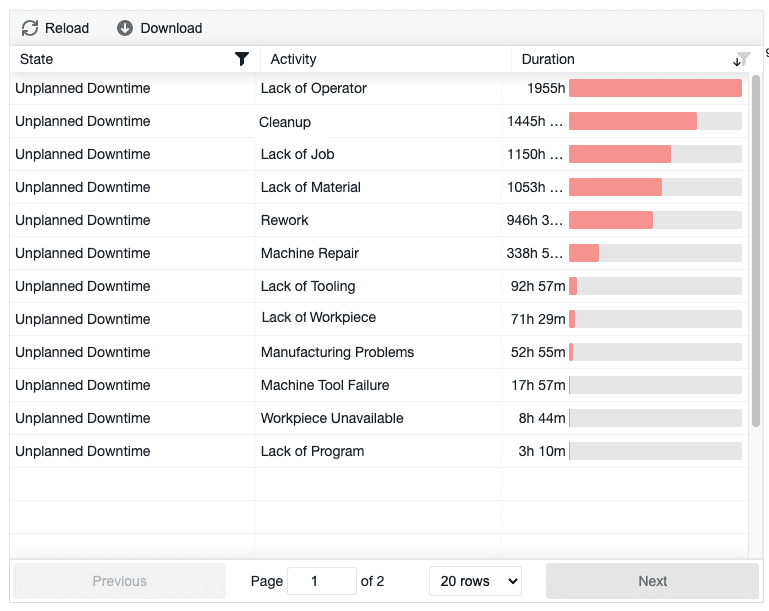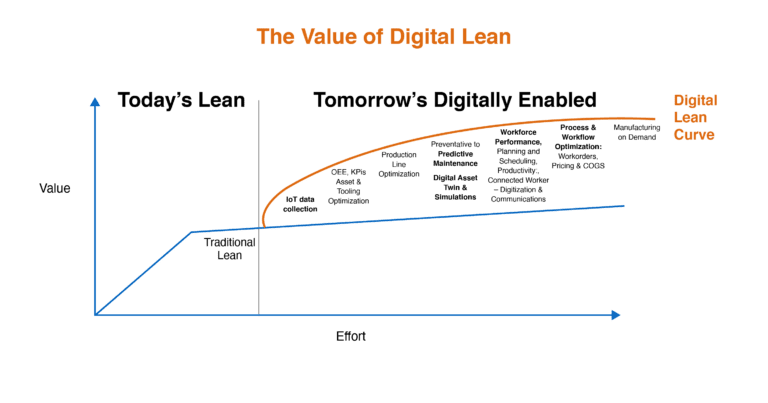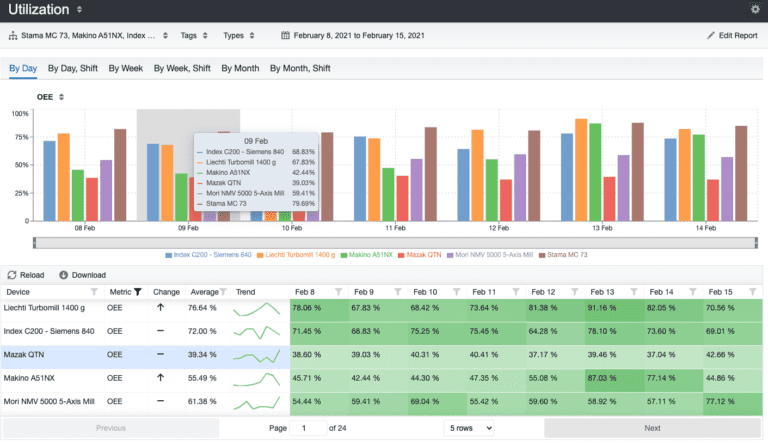What are Lean Manufacturing Tools?
Increase Continuous Improvement Velocity with Lean Digital
Table of Contents
What is Lean Manufacturing?
Eliminate Waste and Improve Productivity
Lean Manufacturing is a methodology focused on eliminating wasteful practices for better productivity and efficiency while promoting customer value. Lean enables quicker responses to changing customer demands, faster production, increased quality at lower costs. Lean provides a way to do more and more with less and less.
Lean relies on the application of lean tools and principles to the development and manufacture of physical products. This approach increases access to information, making problems visible, and engaging employees to help solve these problems—a continuous identification of waste and the execution of small incremental improvements.
7 Types of Waste
There are seven types of waste that lean processes aim to eliminate. They are defined as:

- Transport: Wasted time, resources, and costs with the unnecessary movement of materials, tools, inventory, equipment, or products.
- Inventory: Wastes from excess products and materials that can’t be processed.
- Motion: Wasted effort due to the movement of people. Decrease walk time between workstations.
- Waiting: Wasted time spent waiting for the next process step to occur. Eliminate bottlenecks.
- Overproduction: Waste from making more products than customers demand. Ensure pull production.
- Over Processing: Waste due to more work or higher quality than required. Too many workers assigned.
- Defect: Waste from products that fail to meet customers’ expectations. Reduce scrap and rework.
What Companies Employ Lean Manufacturing?
The majority of manufacturers now embrace lean management. The 2010 Compensation Data Manufacturing survey results found that “69.7 percent of manufacturing companies utilize Lean Manufacturing practices”.
Leading large enterprise companies apply lean tools to improve business results to include: Toyota, Honeywell, GE, Parker Hannifan, Illinois Tool Works, Textron, Intel, John Deere, and Nike. Most recently GE recently published The Lean Way: Culp Gives An Update On GE’s Lean Transformation. Larry Culp, GE CEO speaks about lean being their strategy, it’s how they will run their business, and it’s key to growth.
Small and medium-sized companies embrace lean methodologies to increase customer satisfaction and competitiveness in the global marketplace. Frequently small businesses need an effective production system that can address low volume and a high mix of products. Lean allows manufacturers to identify waste, increase flexibility to ensure delivery of the right product at the right cost. Lean provides a platform for the rapid and sustainable future growth of the business.
History of Lean

The 1800s - Early Versions of Lean
Lean Manufacturing is not a new concept –early versions of the method date back to the 1800’s when Eli Whitney introduced interchangeable parts to manufacture 10,000 muskets at the low price of $13.40 for the US Army. For the next 100 years, manufacturers focused on individual technologies, moving production from one discrete process to another. Their challenge was, what happened between processes. They developed time studies, standardized work, and value stream charting that revealed value add and non-value-add steps. This was the beginning of the idea of eliminating waste.
The 1930s - The Ford System
In the 1930s the Ford System was introduced. Elements of people, machines, tooling, and products were arranged in a continuous system to manufacture the Model T automobile more efficiently. However, the Ford System lacked flexibility and collaboration with front line workers.
The 1950s - The Toyota Production System (TPS)
In the 1950’s Japanese manufacturing leaders launched The Toyota Production System. Using learnings from Ford – Statistical Quality Control practices and Total Quality Management of Ishikawa, Edwards Deming, and Joseph Juran, the Toyota Motor Company, Taichi Ohno, and Shigeo Shingo, began to incorporate these techniques into an approach called Toyota Production System or Just In Time. Shingo addressed set-up and change over time (SMED), reducing setups to minutes allowed small batches in an almost continuous flow. The Toyota system had three objectives: design out Muri (overburden), design out Mura (inconsistency), eliminate Muda (waste). In other words, by focusing on process design and flow, companies can create a system that sustainably creates more value and less waste. Overall Equipment Effectiveness OEE metric was developed in the 1960s to evaluate the effectiveness of the manufacturing operation.
1980s Lean Manufacturing in America
The term Lean Manufacturing was introduced to the Western world via the 1990 publication of The Machine That Changed the World. Since then, lean principles have profoundly influenced manufacturing concepts throughout the world. Lean has been frequently applied in factories to improve operations, untangle production lines and supply chains, and fix other manufacturing issues. Lean manufacturers have now become lean enterprises. Lean Manufacturing stretches out from the factory premises to all stakeholders. This includes suppliers, customers, and all the influencing parties. Lean enterprise concepts are focused on all the people in the supply chain to get the best possible value from the collective effort
Today: Lean Manufacturing in the Digital Age
Today, Lean Manufacturing has gone to the next step. What’s new is the intersection of traditional lean concepts with digital technology. Using big data, advanced analytics, AI, and the internet of things to capture real-time data and predictive insights to drive efficiencies as well as revenue growth. Implementing Digital Lean improves accuracy in decision making, reduces the time and costs in data collection, interpretation, and action. Increasing the speed of change and process improvement. It enables new business models to transform manufacturing operations and ignite competitive advantage.
What are the 5 principles of Lean Manufacturing?
The five principles of lean define the recipe for the journey to create an efficient and effective organization. Lean enables managers to discover inefficiencies, develop better workflows, and create a continuous improvement culture. By practicing all 5 principles, an organization can drive efficiency while increasing its profitability.
There are five main principles of Lean Manufacturing as defined by Womack and Jones in their 1990 publication, “The Machine that Changed the World”.These core principles leveraged in lean implementation are:

Customer Value
- Identify value as defined by the customer and created by the producer. Determine what the customer is willing to pay for. Strive to eliminate waste and cost from processes so that the customer’s optimal price can be achieved — at the highest profit to the company.
Value Stream Mapping
- Document and analyze the steps required to produce a product with the intent of identifying waste and methods of improvement. Anything that does not add value must be eliminated.
Create Flow
- Eliminate functional barriers and identify ways to improve lead time. Ensure processes are smooth from the order through to delivery. Flow is critical to the elimination of waste. Lean Manufacturing relies on preventing interruptions and enabling an integrated set of steps in which activities move in a constant stream quickly.
Establish a Pull System
- Start new work only when there is customer demand. Pull relies on flexibility and agility. Lean Manufacturing relies on a pull system instead of a push system. With a push system, inventory needs are determined in advance, and the product is manufactured based on a potentially inaccurate forecast. This results in swings between too much inventory and not enough and poor customer service.
Pursue Perfection
- A continuous work effort to remove waste and improve performance. A work effort that includes targeting the root causes of issues, eliminating waste across the value stream, and standardizing the processes that generate success.
What are Lean Manufacturing tools?
Lean tools provide frameworks to solve problems, measure performance, analyze and optimize work processes while helping to manage people and change. Lean Manufacturing tools are intended to help drive out waste, simplify everything, create efficient flow, improve quality control, and make the most of factory resources.
There are over 50 different Lean Manufacturing tools that you can implement within your business. This article will focus on 20 of them, and describe how they can be applied to your operation.

Lean Manufacturing Tools |
Definition and How its Applied |
Muda – 7 Wastes of Lean |
Muda within lean is defined as any activity or process that does not add value. Gain visibility to and reduce waste: waiting, idle time, excessive inventory, and product defects. According to a study by PwC, 80-90% of tasks in typical business processes are wasteful because they do not add any value to the customer. |
6 Big Losses |
Total Productive Maintenance – TPM implementation is dependent on understanding the reasons for productivity loss. This is defined by the 6 Big Losses:
|
5 Whys – Root Cause Analysis |
The 5 Whys drive problem solving to the true root cause so that can be fixed. Asking “Why” 5 times in a row will often help us to focus on the leading cause. |
Poka Yoke |
Poka-Yoke is a method of error proofing. Visual inspection is time-consuming and often highly ineffective. Implementing Poka-Yoke methods helps to automatically detect or prevent the creation of defects within our processes. |
OEE |
Overall Equipment Effectiveness (OEE) is the measure used within TPM. A composite measure of overall availability, performance, and quality. It measures productive time. Overall equipment effectiveness can be calculated by multiplying the following three factors: These three factors are defined as follows:
|
Total Productive Maintenance TPM |
Total Productive Maintenance TPM is the process of using machines, equipment, and operator knowledge to improve equipment reliability and reduce operating costs. It is a holistic approach to maintenance that builds on preventative, predictive, and autonomous maintenance. To learn about TPM just click this link: Total Productive Maintenance. |
SMED |
Single Minute Exchange of Die or SMED is a tool to reduce the time spent on changeovers and setups. The goal is to do a changeover of your product in less than 10 minutes. This allows you to increase equipment utilization and reduce batch sizes to a minimum for continual flow. |
Quality Tools |
There are seven Quality Tools that have been traditionally applied to help with problem-solving. These graphic displays ie. Pareto and Scatter Diagrams enable easy interpretation of data. |
JIT- Just-in-Time Manufacturing and Pull Systems |
JIT is an on-demand system of production. Produce just what the customer wants, when and where they want it, without delays or waste. Go into production after the customer order. This reduces inventory and overhead costs while enabling build to order and mass customization. |
Continuous Flow – Single Piece Flow |
The ideal process is one in which product moves one at a time from operation to operation without delay between stations. By implementing Continuous Flow you will immediately highlight any issues within the process as well as reduce the need to hold high levels of work in progress stock. Traditionally plants have areas for machining, welding, painting, etc. Cell manufacturing creates an end-to-end line for production creating a simple pull system. |
Takt Time |
The average time to complete a product. The Takt Time dictates the rate at which each process should operate without bottlenecks or overproduction of components and finished goods. |
Value Stream Mapping |
Value Stream Mapping (VSM) is a diagram of a process that is used to analyze and maximize value and reduce waste. It highlights where action is required within each step and provides a best practice target for the future state value stream. |
Bottleneck Analysis |
Bottleneck Analysis identifies the slowest part of the chain to remove the bottleneck which results in a faster movement through the entire process. |
Inventory Reduction |
One of the biggest of the seven wastes is over-production and the resulting Inventory. Excessive inventory masks many problems and ties up vast amounts of cash. To achieve continual flow and pull production inventory levels must be reduced. |
Line Balancing |
Line Balancing is a lean tool that defines the right amount of people to make the right amount of product within Takt Time. Productivity increases when time and resources are decreased to make the product driving cost out. Identify excess capacity and bottlenecks, then reallocate resources. |
Kanban |
Kanban communicates the need to replenish or produce a component to optimize production planning and procurement. Leverage shop floor communications tools to ensure materials and parts are available to production on demand. |
Continuous Improvement, Kaizen |
Kaizen is dependent on real-time and historical data analysis for competitive advantage. |
Plan Do Check Act (PDCA) |
PDCA is an improvement cycle based on the scientific method of proposing a change in a manufacturing process, implementing the change, and measuring the result in iterative sprints. |
Standardized Work |
Standardized Work documents the current workflow, which defines the baseline for continuous improvement. It relies on collecting data regarding the time required to complete each step of the process. Guiding front line employees to perform their job in the most effective way consistently. |
Visual Management – Visual Workplace |
Visual Management enables the front line and management to see at a glance how things work and move in the factory. It ensures clear communication of information and highlights if something abnormal has occurred. |

Six Sigma DMAIC Process vs. Lean Manufacturing Tools
Organizations often leverage Lean Manufacturing tools with Six Sigma methods. Though there are some differences between the two frameworks, the underlying philosophies behind Lean and Six Sigma complement each other exceptionally well. Lean Manufacturing tools are designed to eliminate invaluable processes, while Six Sigma focuses on lessening variation within a process. When combined, the two are referred to as Lean Six Sigma, a process that reduces and manages different types of waste in organizations. DMAIC is a variation on the PDCA cycle and introduced through 6 sigma.
The DMAIC steps are:
- Define: outline the process, the boundaries for your study
- Measure: collect data on the current state of the process
- Analyze: show the gaps between the goal and current performance and identify the causes
- Improve: design and implement solutions to close that gap
- Control: put in place changes that prevent the process from slipping back into its old ways
The Benefits of Traditional Lean Manufacturing Tools
Adopting Lean Manufacturing tools guides manufacturers to:
- Continuously improve processes through waste elimination.
- Decrease process variability in quality and flow rates.
- Expand production flexibility to enable build to order vs. build to forecast.
- Reduce manufacturing costs by increasing labor productivity, reducing labor hours, lowering inventory, decreasing consumables usage, and contracting factory footprint/space.
- Optimize CAPEX investments.
- Improve production throughput, cycle time, and delivery to meet customer demand.
- Enhance product quality and reduce defects, rework and scrap, and related costs.
Challenges of Traditional Lean
Traditional lean practices face challenges in data collection and real-time advanced analysis of manufacturing processes.
Many manufacturers use manual techniques, a pen, a piece of paper, a spreadsheet, and a stopwatch. The results of manual data collection and data entry:
- Continuous improvement lags behind data collection due to the effort required (time-consuming and labor intensive).
- Delivers inconsistent and inaccurate data that is not trusted for decision making.
- Outdated information making it impossible to fix issues while they occur.
Some manufacturers have difficulty building a data foundation of relevant real-time data that answers the critical business questions.
- Sensors, machines, manufacturing, and business processes generate large volumes of data that needs to be cleansed, normalized, and enriched to build a robust, reliable data foundation for advanced analytics, AI, and machine learning.
- However, you must go beyond building a data lake. The data must be transformed into insights that answer key questions, used in lean workshops, and deliver real business outcomes.
Next-Generation Lean: Digital Lean
As companies and organizations face the ‘Next Normal’ and changing customer demands, digitization is critical to their recovery and success. The ‘Next Normal’ requires new ways of working and new technology. Manufacturers must adapt to remote work, accelerate collaboration and accountability, speed up decision making, transition to just-in-time, and rethink manufacturing processes to optimize resiliency. Using Lean management techniques as the framework in combination with digital technologies can enable manufacturers to realize the ‘Next Normal’.
What is Digital Lean?
The purpose of lean management remains the same, creating value by optimizing resources and continuous improvement of every process with the engagement of employees. Digital Lean leverages the value of Industry 4.0 technologies, automated data collection, IoT advanced analytics, and AI to provide manufacturing intelligence to decrease waste and variability in processes. Digital Lean is a catalyst for transformation to the ‘Next Normal’ helping companies reduce costs while fostering flexibility.
The Value of Digital Lean
Manufacturers focused on continuous improvement using only traditional tools (lean, lean six sigma), make great progress initially, but their productivity shrinks over time. With Digital Lean, the manufacturer can build on its lean foundation and leverage advanced analytics, machine learning, and predictive maintenance, to solve previously unsolvable business problems and reach new levels of productivity. Digital Lean produces more information on all aspects of the production process. It provides more accurate and precise information about operations. It increases the impact of core lean tools with the availability of a high volume of data to reveal insights that are impossible without it.
“Bain finds that while traditional lean typically produces a 15% reduction to key operations costs, Digital Lean adds a 100% improvement on top of that, for a 30% cost reduction.”, published in “Digital Lean: A Guide to Manufacturing Excellence”, 2019, by Bain & Company.

Digital Solves the Challenges of Traditional Lean Practices
Digital Lean solves the challenges of traditional lean by delivering automated IoT data collection, cleansing, preparation, and enrichment from legacy, digital, and manual stations and lines. Collect and analyze data faster and more accurately with fewer resources. Automatically generate customized, persona-based visualizations of valuable production information that is easy to interpret for immediate action. Harness large amounts of data for analysis to address varied use cases and stakeholder needs. Distribute and share the data across the enterprise as well as remotely. Integrate with siloed systems and data to drive deeper process insights. Power AI, predictive analytics, digital twins to change the way you work – take actions before issues happen and simulate processes before implementation.
Digital Lean Enhances Lean Manufacturing Tools Value
Traditional Lean Manufacturing Tools | Advanced Analytics Increases the Impact of Core Lean Tools |
Muda – 7 Wastes of Lean | Accelerate waste identification and immediate improvements with real-time data. Leverage analytics to understand wait time for equipment maintenance, tooling, or materials. Find hidden waste with more detailed information. Uncover bottlenecks that result in excess WIP inventory. Use analytics to monitor bad parts and quality issues. |
6 Big Losses | Automated IoT data collection, advanced analytics, and visualizations reveal the top reasons for production loss. Real-time visibility and trend analysis provide insights into downtime, set-up time, stoppages, machine speed, and good part bad part yields. |
5 Whys – Root Cause Analysis | Advanced analytics software provides algorithms as well as capabilities for employee feedback to categorize production loss casuals. Standard reporting provides duration and trend insights. Analytics automates problem-solving and identifies the true root cause with drill-down insights. |
Poka Yoke | Advanced anomaly detection and predictive analytics can help reduce human error, which causes defects. Industrial Analytics software solutions detect abnormalities and predict failures that could result in defects. Alerts inform teams proactively to unwanted conditions for a quick resolution. |
OEE | Automatically calculate OEE. Use real-time dashboards to monitor performance. Compare OEE performance consistently. Communicate performance from shop floor to leadership. Drive accountability. Measure the impact of process improvement. |
Total Productive Maintenance | Use sensors, machine data, condition monitoring, advanced anomaly detection, and predictive analytics to extend preventative maintenance schedules, optimize tooling usage, diagnose and reduce asset failures. Implement alerts of machine alarms and faults to communicate risks. |
SMED | Monitor actual performance of changeovers and setups by part. Manage and control set-up performance with automated Alerts to communicate when the target threshold is exceeded. |
Quality Tools | Improve the quality with data analytics. Customize charts by stakeholders to visualize data for rapid interpretation. |
JIT- Just-in-Time Manufacturing and Pull Systems | Real-time data analytics provides the insight to achieve build to order and enable flexibility to rightsize to meet customer demand. With visibility to capacity and workforce performance, scheduling can be optimized. Track production line performance, total throughput -Takt time, downtime at asset and line level, and enable data-driven Alerts when line actuals are beyond targets. |
Continuous Flow – Single-Piece Flow | Utilize real-time data to understand each step of the process, monitor cycle time, and uncover delays. Implement Alerts for proactive management and quick resolution. Leverage shop floor digitization tools to automate communications, enable self-directed training (work instructions), and drive shift handover efficiency (digital logbook). |
Takt Time | Automatically calculate and monitor Takt Time. Analyze historical performance data to establish realistic targets. Monitor and control each step to avoid missed delivery dates. |
Value Stream Mapping | Analytics provides insight into the current state and the time it takes for each step of the value stream. Leverage the trend data to compare performance and determine the future state value stream. |
Bottleneck Analysis | Real-time data analytics reveals stoppages or slow down in assets, lines, or manual stations. Uncover bottlenecks and optimize capacity for faster movement through the entire manufacturing process. |
Inventory Reduction | Stop overproduction and achieve pull production with analytics to improve dynamic demand forecasting and reduce risk in the manufacturing process. |
Line Balancing | Real-time performance data and automated line balance reporting provides information regarding actual cycle vs takt time. Use Alerts to manage & control processes when thresholds are exceeded. |
Kanban | Real-time data and digital twins can help optimize production flow and pull production. |
Continuous Improvement, Kaizen | Advanced analytics dashboards and reports support lean workshops and day to day GEMBA meetings. Compare shift performance, understand operator productivity and lights out efficiency, line and asset utilization, cycle time, and part production. Use analytics insight beyond what can be observed. Achieve continuous improvement, Kaizen with real-time data and continuous monitoring. |
Plan Do Check Act (PDCA) | Determine attributes to track to find answers to problems. Automate data collection, test assumptions, Kaizen station/process, and use data analytics to measure results. |
Standardized Work | Standardized work is enabled by measuring Takt Time, OEE, other KPIs and defining the precise work sequence in which an operator performs tasks to reflect best practice. Analytics and dynamic work instructions enable change. |
Visual Management – Visual Workplace | Advanced analytics and customized dashboards display performance on the shop floor. Use automated factory layout to visualize problem areas and communicate performance. Leverage remote monitoring capability to enable remote work and enable social distancing. |

6 Steps to Implement Digital Lean
Define your most urgent business problems. Meet with leading stakeholders to understand their most pressing needs and problems.
- Prioritize areas with the largest payback. Identify the largest areas of opportunity to include unlocking the capacity of constrained equipment and processes, increasing asset efficiency, reducing labor spend, and improving quality.
- Start small with a pilot. Choose an operational issue, engage personnel in training and process improvement, and measure results.
- Integrate and leverage other business systems and data. Integrate with legacy systems to exchange data and automate workflows.
- Augment lean tools with advanced analytics to guide lean workshops and improve the production process.
- Scale and expand use cases. Continuously expand use cases and stakeholder engagement to provide incremental value to your enterprise.
Learn more about how advanced analytics powers Digital Lean. Get started with your journey today. VIMANA’s Industrial analytics has been used to implement Digital Lean for large and small manufacturers across the globe.

